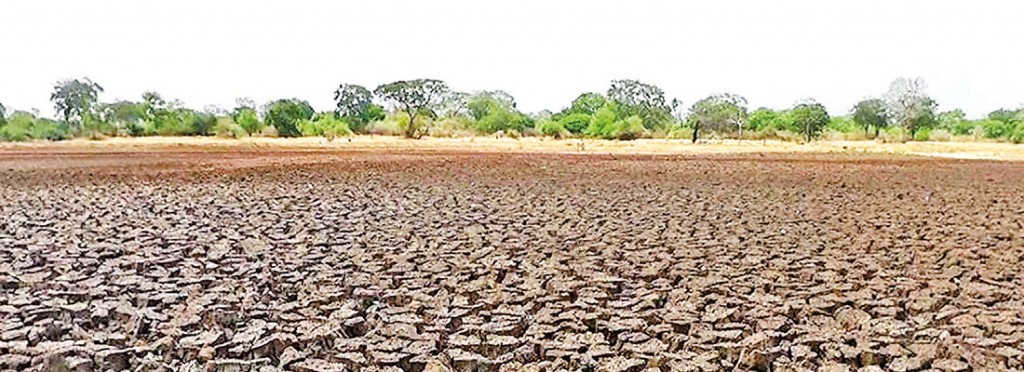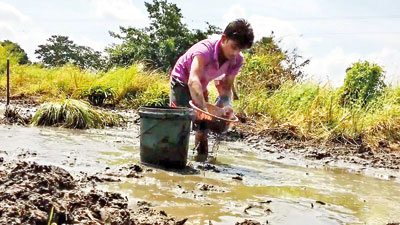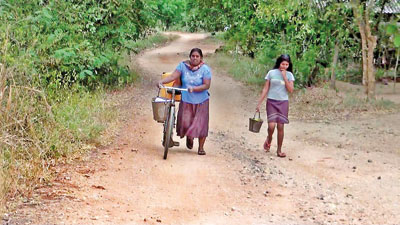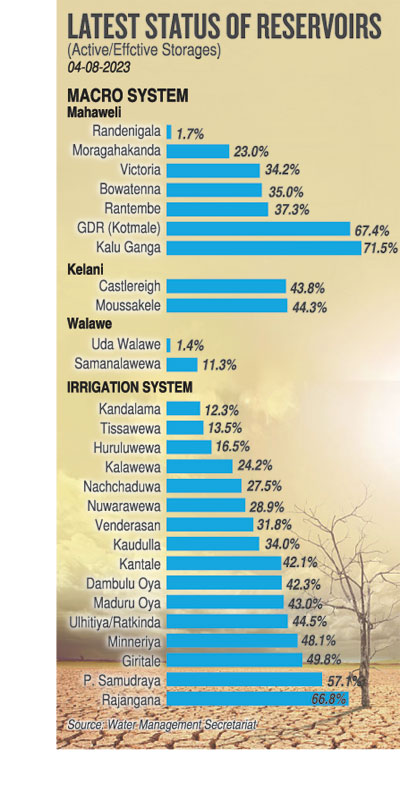News
Reservoirs have dried out, putting water supply in danger zone
View(s):
Tank beds have been revealed due to harsh drought conditions.
By Nadia Fazlulhaq
The country is heading towards water scarcity due to the prolonged dry spell, which is expected to last several months.
“Water levels in small-to-major reservoirs are dropping at an alarming rate while underground water sources are drying up. Releasing limited water to sectors is becoming a hard task with water management panel meetings turning chaotic,” said Nilantha Dhanapala, additional director general of the Mahaweli Authority and director of the Water Management Secretariat.
The Water Management Secretariat allocates water for agriculture, power generation, pipe-borne water, wildlife, and commercial purposes.
“There has been no rainfall for the past two-and-a-half months in all irrigation systems and reservoir areas. Also, farmers exceeded their permitted use of water by increasing paddy cultivation and reducing other supplementary crops,” he said.
The present water storage level at Randenigala reservoir is only 2.5%; Victoria reservoir has only 34.2%; Rantembe 30.5%; Moragahakanda has 23.8%; and Bowatenna has 36.3%. Both Castlereigh and Moussakelle water storage levels stood at 44.8%. Udawalawa reservoir’s water level dropped to 1.7% and Samanalawewa’s to 11.7%.

Rivers and streams running dry
Kotmale and Kalu Ganga reservoirs were the only ones with satisfactory water levels of 67.7% and 71.5%, respectively.
“The dry weather is also triggering evaporation. In Kala Oya, about 150 acre-feet of water had evaporated, and about 1400 acre-feet of water in Maduru Oya has also evaporated,” Mr. Dhanapala said.
Only three major irrigation tanks in Anuradhapura have enough water; all others have water levels below 30%, irrigation director for Anuradhapura S.D. Mediwaka said.
He said there is a drinking water crisis in the Anuradhapura district, with water levels in Thuruwila (58%), Nuwara Wewa (31%), and Tisa Wewa (18%) remaining low.
“Requests have been made to release about 1,000 acre-feet of water for those tanks for drinking water and another 2000 acre-feet for Thuruwila and Nachchaduwa to be used for Yala paddy cultivation,” he said. Water levels in Abaya Wewa have gone down to 10%, Padaviya to 17%, and Hurulu Wewa to 21%, making Anuradhapura the worst-affected district.
Agitated farmers have been protesting and demanding officials provide water for paddy and other crop cultivation, for cattle, and for drinking.
“Our farmers want the Mahaweli Authority to release water to Kala Wewa from Kotmale reservoir. If not, over 25,000 acres of paddy land will be destroyed,” said Y.H. Dissanayake from the Mahaweli H Zone farmers collective.

Rivers and streams running dry
In Kilinochchi, dairy farmers have demanded that the authorities provide water for pastures affected by dry weather. They charged that milk production has been reduced by 50% due to the unavailability of fresh grass.
Meanwhile, water bowsers are being sent to rural areas and areas not covered by the National Water Supply and Drainage Board (NWSDB).
The Disaster Management Centre said it has deployed water-filled bowsers to drought-stricken areas in Kurunegala, Puttalam, Vavuniya, and Trincomalee districts during the past few days.
Anoja Kaluarachchi, deputy general manager (development) at the NWSDB, said pooling arrangements are being made and water supplies are sent to required areas on a weekly basis.
“Curtailing supply is taking place in some areas. Whenever there is low pressure, people collect water in large quantities. This makes it difficult to supply the most needed healthcare services,” she said.
She said protesting farmers are also blocking the anicuts in Hambantota. 
Ms. Kaluarachchi said that as both Castlereigh and Laxapana have more than 40% storage levels, there is no threat to the supply of water to Colombo city and its suburbs, especially if water is released after power generation.
“Only 48% of the population uses pipe-borne water. The others have their own sources, from wells to streams. The Government will have to continuously provide water for those affected by this dry spell,” she said.
She asked people to use water wisely, as the remaining water in reservoirs and tanks has to be used for at least two months.
Meteorology Department Chief Athula Karunanayake said the months-long dry weather will continue until October.
“The southwest monsoon, usually from May to September, brought much less rain to the western slopes of the central hills. This is the reason the reservoir water levels remain low. Usually, these months are warm months, but due to the weak monsoon, the dry spell is felt all over the country,” he said.
He said the El Nino effect had a direct impact on the extended dry spell.
Dr. J.M.S.B. Jayasundara, senior lecturer in environment management at Rajarata University, said farmers who had gone through a fertiliser crisis and water use for hydropower in previous years made maximum use of water this time and increased paddy cultivation.
“There are international bodies which pay compensation for farmers affected by climate change. The Government should closely coordinate and ensure that farmers benefit even if an unexpected weather phenomenon occurs. Technology and advanced forecasting systems should be in place to minimise losses,” he said, adding that drought-tolerant rice varieties will be necessary in the near future.
Pix by B.G. Chaturanga,
Thisara Sumal and
Romesh Madushanka
The best way to say that you found the home of your dreams is by finding it on Hitad.lk. We have listings for apartments for sale or rent in Sri Lanka, no matter what locale you're looking for! Whether you live in Colombo, Galle, Kandy, Matara, Jaffna and more - we've got them all!

